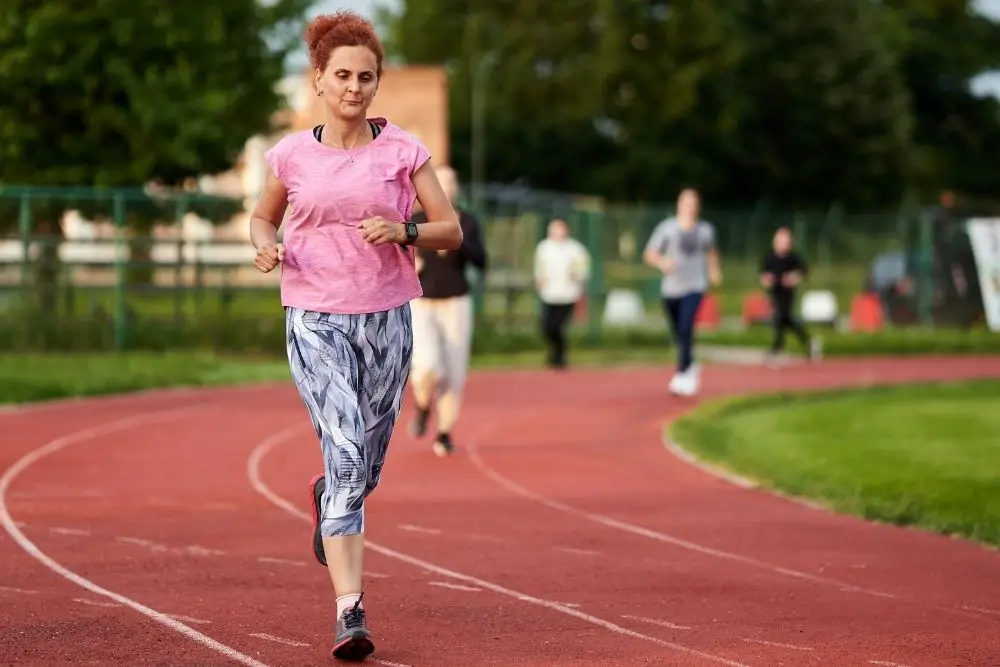Running is a fantastic exercise to help you stay fit and healthy, as it builds strong bones, strengthens muscles, improves cardiovascular fitness, and burns off plenty of energy to help you maintain a healthy weight.
As a kid, most of us were fortunate enough to be able to run around freely without any worry of pulled muscles, and certainly with no consideration of running form!
Mindlessly running around with friends, arms flailing, and a smile on our faces, truly living in the moment.

Now, though, it can be easy to cause a strain or injury due to several reasons such as poor conditioning, environmental hazards, and especially through improper running form or technique.
So, what is, and how do you develop, a proper running form?
Proper running form is simply a technique that will ensure improved performance whilst reducing the likelihood of picking up a strain or injury.
It allows the runner to be more economical with their energy, using less of it to run the same pace and therefore can reach faster speeds with the same effort.
It is alarmingly easy to injure yourself running, from pulled muscles to bruised feet, from back strain to jarring your knee. Though I implore you, please worry not!
This article contains some useful hints and tips on how to improve your running form and, by default, your performance, health, and fitness.
Even professional athletes and sports stars are continually working on improving their techniques in their fields to ensure optimal performance and that they can reach their true potential.
“I think a lot of people, they see you run, and they say, ‘Aaah it looks so easy, looks effortless’. But before it gets to that point, it’s hard; it’s hard work.” -Usain Bolt
Brief Summary of Proper Running Form
To briefly summarize, a proper running form requires the following:
- The head should be over the shoulders and upright
- The shoulders should be over the hips
- The hips should be over midfoot
- The feet should land slightly ahead of the center of gravity
- Arms should be bent at 90 degrees and allowed to swing near the side of the body – not swinging wildly from front to back
- Fingers should be placed together lightly and comfortably without a tough grip or tension
Focusing on Your Cadence
What is cadence while running?
Cadence is also known as stride rate, it refers to the number of steps a runner takes per minute (SPM). It is the most commonly used metric to measure running across all sports and events.
Optimal cadence is generally considered to be around 180 SPM, although this will be dependent on each individual. Slower runners may want to aim for around 165 SPM, whilst faster runners should aim above 170 SPM.
Finding out your current cadence is a simple task.
It requires you to run for thirty seconds and count the number of times that your left foot hits the ground, this can then be doubled to find the number of steps per minute.

Focus on Where Your Foot Lands
Where your foot lands when running is an essential aspect of having a good running form.
When a runner over-strides, their legs land too far ahead of their bodies, which can cause uncomfortable and possibly dangerous heel striking.
Whilst short strides are effective for short distances and sprinting, over longer distances this can cause damage to the toes and ball of the foot.
To strike the ideal balance, the foot should land directly under the hips or underneath the body’s center of mass.
This might take some time to adjust, but it’s worth putting in the time and effort to correct this.
Posture is Key
Many runners tend to lean forward into their stride, believing it to be the natural position when running. However, this can cause issues with balance, cadence, and foot positioning.
The ideal method is to run with a tall back and good posture, this allows a more efficient and smoother running technique.
Then, the momentum of the correct form will cause a slight natural lean forward that will not cause any detrimental effects.
Be Conscious of Your Arms
Although running around as a kid (or an adult) wildly waving your arms can be a lot of fun, it doesn’t exactly help with creating proper running form.
The arms should naturally move with the legs and strides a runner takes, it’s not necessary to throw them back and forth like a pendulum in an effort to improve speed.
What is Tailwind?
Tailwind Nutrition is the brainchild of Jeff and Jenny Vierling, who decided to develop it after being left feeling dissatisfied and disappointed with many products already on the market.
It is a powdered product that simply needs mixing with water to consume for some incredibly beneficial advantages both before and after exercise.
Their product range consists of two main supplements, Endurance Fuel and Recovery Mix. Both are designed to work within the body’s natural processes to ensure the optimum absorption and benefits for both performance and recovery.
Endurance is described as ‘complete energy + electrolytes + hydration’, the glucose fuels the drinker’s muscles which support more intense exercise over a longer time.
Recovery Mix is described as ‘complete protein + carbs + electrolytes’, which also contains sodium, potassium, calcium, and magnesium to restore electrolyte balance in the body after exercise.
It is designed to make the most of the so-called “golden hour” after exercise, a time in which the body is most productive at restoring glycogen stores.
Their products are available throughout the US and are also shipped worldwide to enthusiastic runners, professional athletes, and those playing all manner of sports.
These are also fantastic for those in physically demanding professions or those undertaking strenuous exercise like hiking.

Conclusion
Taking the time to work on, develop, and improve one’s running form is a practice that should be undertaken by anyone that’s running more than simply to catch the bus!
The benefits of proper form to both performance and health make it a truly worthwhile challenge.
Hopefully, anyone reading this can take these hints and tips on board and use them to develop their own running form.
Believe in yourself and take it one step at a time (literally)!
“The man who moves a mountain begins by carrying away small stones.” — Confucius

